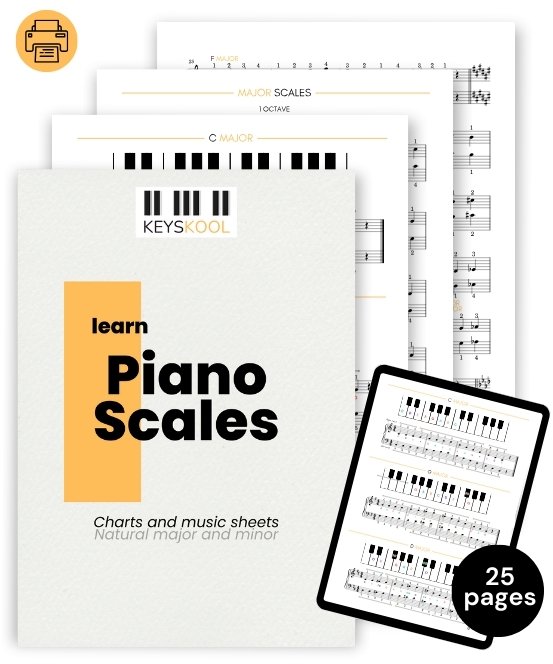Embrace the Keys: use the best fingering for piano scales
Proper fingering in piano playing is akin to the foundation of a sturdy structure. It forms the fundamental basis for achieving fluidity, precision, and ultimately, musical expression. Mastering fingering is not just about hitting the right keys; it’s the key to unlocking enhanced agility, enabling fingers to effortlessly navigate the keyboard. This mastery translates into heightened speed, allowing for smoother transitions between notes and facilitating intricate passages. Overall, precise fingering is the secret to unlocking the full potential of a pianist, transforming the act of playing into a seamless and captivating performance.
Understanding fingers numbers
In the world of piano playing, understanding the standard finger numbering system is the first step toward mastering the keys. Each hand is assigned five fingers, numbered from 1 to 5.
Starting with the thumb as Finger 1 and progressing towards the pinky as Finger 5, this system provides a universal language for pianists.

Here’s a quick breakdown of the role of each finger:
- Thumb (Finger 1): Positioned as the innermost finger, the thumb is known for its versatility. It often takes the lead, crossing under other fingers to reach keys and providing stable support for hand movement.
- Index Finger (Finger 2): The second finger, or index finger, is crucial for precision. It navigates between the keys, playing a vital role in melodic runs and chords.
- Middle Finger (Finger 3): Positioned between the index and ring fingers, the middle finger is robust and plays a central role in executing complex passages and maintaining balance.
- Ring Finger (Finger 4): Slightly shorter than the middle finger, the ring finger is adept at handling intricate passages and often collaborates with adjacent fingers for harmonious play.
- Pinky (Finger 5): The outermost finger, or pinky, is vital for reaching distant keys and executing quick, precise movements. While it may be the smallest, it plays a crucial role in achieving dexterity.
Printable Practice Piano Scales PDF
Practicing piano scales is among the best exercices to get fingers strengh and agility. With our piano scales guide designed specificaly for beginners, you will master the main and basic piano scales quickly, easily and with a touch of fun.

Understanding the natural position of each finger on the keyboard is fundamental for fluid and controlled piano playing. As you delve into the world of music, these finger basics will serve as your foundation for expressive and skillful performances.
The Basics of Fingering for Scales:
Understanding the intricacies of fingering is crucial for any pianist, especially when navigating major and minor scales. Let’s break down the basics:
1. Major Scales Fingering:
- Begin with the thumb (1) and assign each subsequent finger a number up to the pinky (5).
- Visualize a natural hand position, ensuring each finger corresponds to the appropriate key.
- Use visual aids or graphics to illustrate the finger placement for each note of the major scale.
2. Minor Scales Fingering:
- Like major scales, assign fingers to each note of the minor scale.
- Pay attention to variations in fingering due to different types of minor scales (natural, harmonic, melodic).
- Visual aids can help distinguish fingering patterns between major and minor scales.
Visual Aids:
- Utilize diagrams or illustrations showing hand positions on the piano keyboard.
- Highlight finger numbers on keys to enhance comprehension.
- Offer a step-by-step visual guide for both major and minor scales.
By incorporating visual aids, pianists can better understand the nuances of fingering, paving the way for more confident and expressive scale practice. Elevate your playing by mastering these fundamental techniques. 🎹✨
Tips for efficiency piano scales practice
- Mindful Hand Coordination:
- Develop hand coordination by practicing scales and arpeggios slowly, paying close attention to the alignment of your fingers.
- Gradually increase the tempo as you become more comfortable, ensuring a smooth and synchronized movement between both hands.
- Finger Transitions:
- Focus on seamless transitions between fingers, especially during scale runs or intricate passages.
- Practice finger crossovers and under movements, ensuring minimal disruption in the flow of your playing.
- Fingering Charts and Graphics:
- Utilize fingering charts and graphics for various scales to visualize proper finger placement.
- Familiarize yourself with standard fingering patterns, making it easier to navigate the keyboard effortlessly.
- Isolate Challenging Sections:
- Identify challenging sections within a piece and isolate them for focused practice.
- Break down complex passages, working on finger transitions and coordination until each movement feels natural.

- Dynamic Finger Strength and Flexibility:
- Incorporate finger strengthening exercises into your daily practice routine, emphasizing individual finger strength.
- Enhance finger flexibility through exercises that promote controlled and independent movements.
- Slow Practice for Precision:
- Start slow and gradually build speed to ensure precision in fingering.
- Use a metronome to maintain a steady tempo, allowing your fingers to adapt and strengthen over time.
- Play with Expression:
- Experiment with different fingerings to discover what feels most comfortable for specific passages.
- Consider musical expression while choosing fingerings, adapting them to bring out the nuances and emotions in your playing.

“To live is to be musical, starting with the blood dancing in your veins. Everything living has a rhythm.”
– Michael Jackson
Efficient fingering not only enhances technical proficiency but also contributes to the overall musicality of your performance. Embrace these tips, and watch as your fingers dance effortlessly across the keys, creating a symphony of harmonious melodies.
